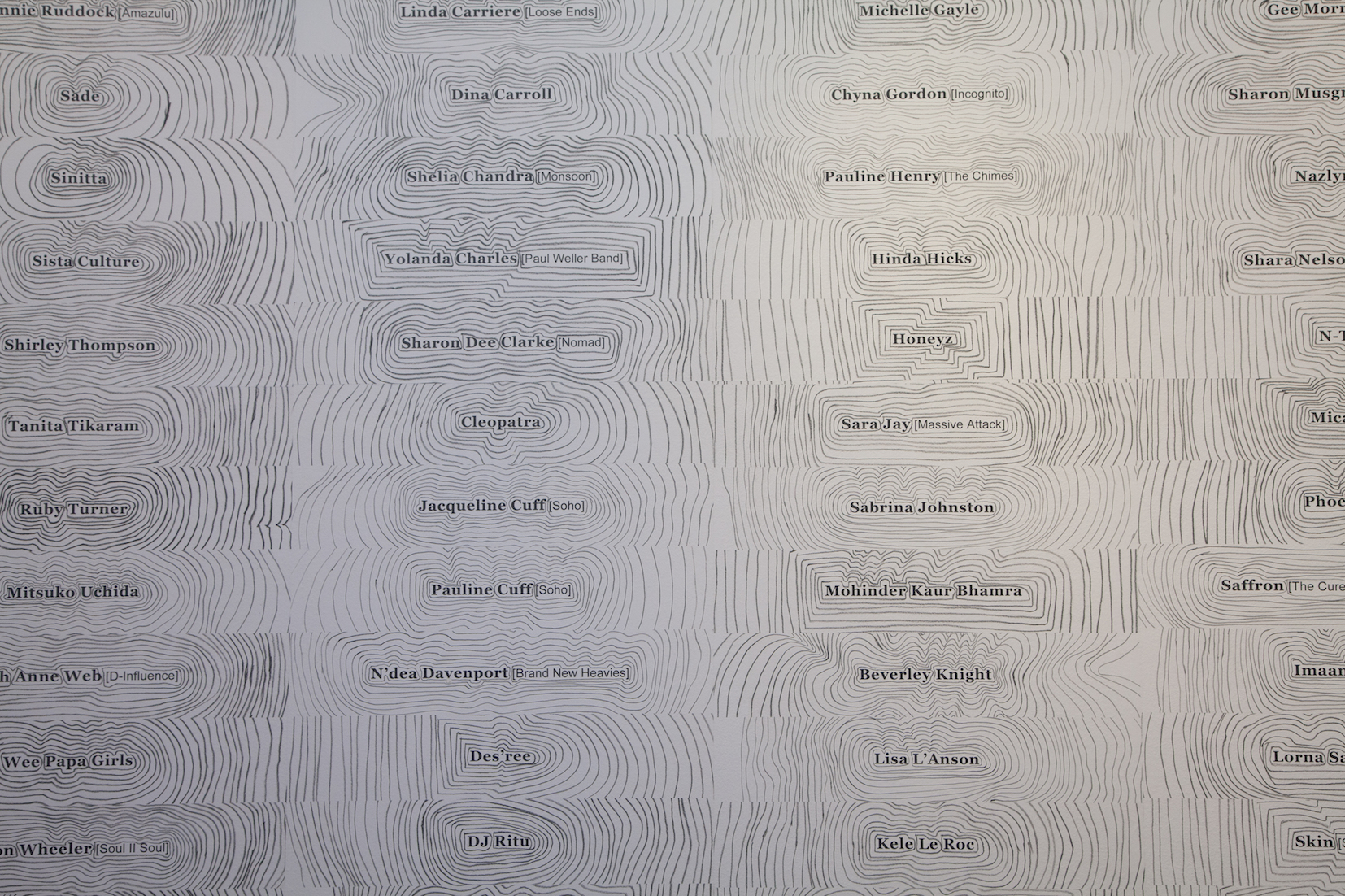Rethinking, re-visiting and reworking history appears as a major concern in Sonia Boyce’s oeuvre spanning almost forty years, as a critique of historical narratives inherent in archival processes and knowledge production. This can be perceived on one level through the use of grids and seriality in the Devotional Wallpaper. Wallpaper has been a recurring means for the presentation and deconstruction of representation in Boyce’s larger practice. As a domestic and everyday object, the use of wallpaper as an aesthetic form enables Boyce to appropriate and transform symbolic and spatial constructions between public and private spaces so as to “tell stories” – stories that can contribute to a re-writing of history (Boyce quoted in Tawadros 1997: 39). In 2007 Boyce installed the first manifestation of the Devotional Wallpaper at London’s National Portrait Gallery as “an elaborately hand-drawn installation on the gallery walls” (Otchere 2007). The names of one-hundred and eighty black British female singers and performers are presented chronologically through a dialectical narrative structure of black/white, inside/outside, centre/margin and space/time. Through a particular repetition of these dialectical frames the Devotional Wallpaper exposes the inherent contradictions between these foundational dualisms whilst simultaneously refusing to resolve them. In particular the Devotional Wallpaper sustains and extends Boyce’s critique of assumed relations between history and memory through aesthetics that subversively appropriate the generic conventions of a list or map, its order and chronology, whilst radically questioning them at the same time. What Boyce’s use of seriality and grids in the Devotional Wallpaper references, and ultimately reworks, are the notions of modernity, chronology and history themselves.

Serialisation is a characteristically modern process. Seriality and chronology display a concern with modernity as processes central to modernity itself. Serialism displays a continual movement of from here to there, a temporal progression, “between ‘here’ and ‘somewhere else’”, which as an occupation of time and space is organised so as to actively frame experience in the world, as a “succession of historical moments” (Bhabha 1994: 147; 150). The wallpaper seriality engages a gestalt-like activity of framing and de-framing, of forming and de-forming so as to simultaneously organise and transform perception and experience and ultimately, to critique and transform historical norms and assumptions. For the figure of the frame here is reversible, on one hand the frame – the lines surrounding the names – stands outside the work, providing a background against which the framed content can emerge as a figure. On the other hand, the frame becomes part of the figure when seen against the background space of the wall. This oscillating play with gestalt and the grouping of ‘successive moments’ relates also to psychoacoustic theories of listening, in that we commonly switch our listening focus in a similar manner, blocking out one sound so as to focus in on another in a noisy environment for example (Chowning et al 2001: 32-35). But, in both an auditory and visual sense, this is more than a Derridian play with the de-centring of absence/presence, as both Houston A. Baker Jr. and Homi K. Bhabha each elaborate upon respectively through their own analytical work (Baker 1987: 16; Bhabha 1993: 148), and which I will return to in forthcoming posts. For now, what can be perceived as occurring in this gestalt of seriality, can be appreciated as a post-Foucauldian reverse discourse of modernist form. It is a process that engages shifting perspectives of context, content and form and their inter-relation, rather than a simple reversal that would seek to replace one term, one category or one sound with the other. Oscillating between ground and figure, the problematic boundaries of the frame as margin both centres and de-centres the work through a performative rather than metaphysical play of absence and presence, engaged in contextual reversals and formal oscillations between repetition, variation and periodicity, “signified in the narrative temporalities of splitting, ambivalence and vacillation” (Bhabha 1994: 147; Julien & Mercer 1988). This de-centring and de-marginalising seeks to expose the gaps between names, words, identities and their assumed meaning, between identities and their assumed place, exposing the gaps between history and memory and sound.
Resounding Histories
In an effort to explain the modernist challenge that the Devotional Wallpaper and the archive itself engages, it is necessary to briefly address the norm which Boyce may be perceived as working against. Normative understandings of modernity and modernism engage linear assumptions about time and history, where pre-modern, modern and post-modern periods considered through a legacy of enlightened rationalism are largely taken for granted as the natural order of things. This is stating the obvious, but, this as I understand it, is the normative progress narrative, or ‘framework,’ that the Devotional Collection seeks to challenge and which I expand upon more throughout this chapter. Additionally, Jacques Attali’s discussion of the “historical and musicological tradition” that would “like to retain an evolutionary vision of music, according to which it is in turn ‘primitive’, ‘classical’, and ‘modern’” (Attali 1985: 10) similarly echoes historical desires for a musicological linear narrative, where ‘evolutionary’ and ‘primitive’ become extremely loaded terms. I want to suggest, and will elaborate upon in following posts, that the structure of the wallpaper, its chronological, linear, horizontal and vertical axial structure, its very dialectical and cartesian seriality, has been designed specifically and strategically by Boyce to reproduce and transform the historical linearity of an assumed evolution that Attali, among others, claims as an illusion (Attali 1985; Baker 1987; Gilroy 1993; Bhabha 1994; Butler 1999; Moten 2003; Sterne 2003; Holland 2012).
